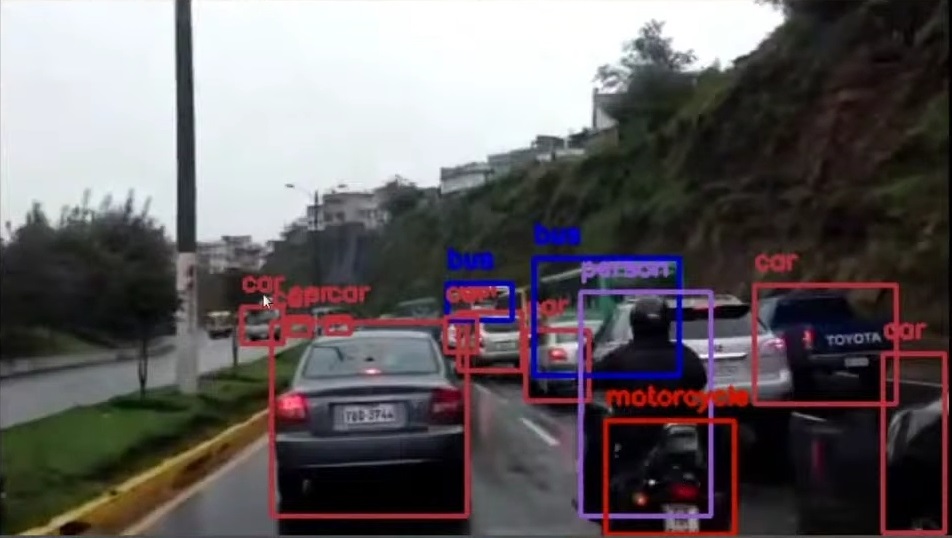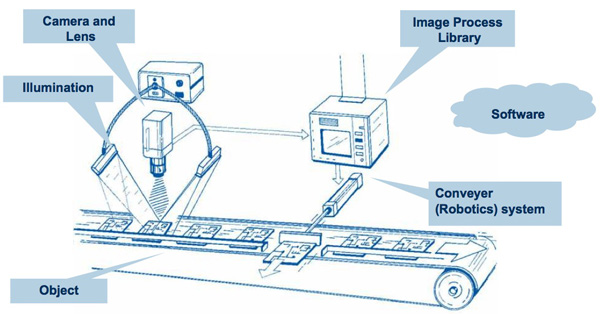Difference Between Computer Vision and Machine Vision
In the present day and age, humans are trying to get machines to do all that they were meant to do. It is not very difficult for the machines to perform simple mechanical tasks, but when it comes to more complex tasks, machines are given the sense of vision – the one that provides most of the data it receives, of all the five senses. This idea is not new; in fact, it’s been a fascinating stuff of science fiction for years now, but it’s a reality now.

Computer Vision
Computer Vision (CV) is the science of replicating parts of the complexity of the human vision system in order to extract useful information from digital images or videos. CV is a field of computer science that deals with technologies and tools to make computers to see what you see and interpret the world around them. Thanks to the technological advancements in the field of AI and Machine Learning, computer vision has taken a huge leap toward the future. The idea is to create digital systems by replicating the human vision system with the goal of processing, analyzing and understanding digital images, and extract meaningful insights from the real world. Computer vision aims to automate tasks that the human visual system can do. Simply put, it ensures the machines understand an image just the way we do or sometimes, better.

Machine Vision
Machine Vision is the use of existing technologies and tools to help machines accurately communicate particular data or information in new ways and apply them to solve real world problems. The application field of machine vision is more or less specific to the industrial environments, where the tasks are very specified and the situations are simplified and well known. Today, it encompasses all industrial and non-industrial applications. One of the most common applications of machine vision system in practice is product inspection in a manufacturing operation. Before designing a machine vision system, the tasks and conditions need to be evaluated. It is also used across varied business application areas such as inspection, guidance, identification, tracking, and more. The processing of images delivered to the computer by sensors is truly the core of machine vision.
Difference between Computer Vision and Machine Vision
Definition
– Computer vision is a field of AI that focuses on replicating parts of the complexity of the human vision system in order to extract useful information from digital images or videos. It enables computers to process, interpret and understand the visual world. Machine vision is a subset of computer vision that uses digital input captured by a camera or multiple cameras to determine action, such as automating tasks, usually in an industrial or productive environment.
Goal
– The goal of computer vision is to create digital systems by replicating the human vision system in order to process, analyze and understand digital images, and extract meaningful insights from the digital input. The idea is to extract useful information from digital images or videos. Machine vision, on the other hand, aims to substitute capabilities of the human visual system with a camera and a computer in order to gather as much useful information as possible of the visual world and neglect the unnecessary information.
Applications
– Computer vision system is used in several important applications such as image classification, face detection, object detection, image searching, object tracking, image captioning, and so on. With the inception of deep learning methods, the most recent applications of computer vision are in self driving cars, robotics, industrial automation, Virtual Reality, and Augmented Reality. Machine vision systems are mostly used in the industrial and productive environment for imaging-based automatic inspection and flaw detection, object classification, identification, robot guidance, packaging inspection, bar code reading, color verification, pattern matching and so on.
Computer Vision vs. Machine Vision: Comparison Chart

Summary
Computer vision systems seek to extract useful information from digital images or videos, and Machine Vision extends the applications of computer vision in industrial or productive environment. The former focuses on understanding the digital input fully after acquiring, processing and analyzing the images. However, not all the industrial applications require the advanced capabilities of computer vision systems, and this is where machine vision comes to the picture. Unlike machine vision systems that require a camera and a computer, computer vision systems can be used alone.
Which is better computer vision or machine learning?
Computer vision is used to train the computers to generate an understanding of the visual information captured from digital images or videos. Machine Learning is the use of computer vision systems in real world interfaces. Both the technologies complement each other.
Is computer vision harder than machine learning?
Creating a computer vision system is a challenging task in itself; part of the problem is the complexity of visual data. And it’s even more difficult to make machines to perform complex visual tasks.
Is computer vision better than human vision?
Computer vision is great for less complex visual tasks, like defect identification in objects. Computer vision is not impossible, but it is very challenging. It mimics the capabilities of how the human brain processes visual information, but the computer vision technology is mostly uniform across all parts of the field of view.
Is computer vision under machine learning?
Computer vision and Machine Learning are two overlapping technologies that are closely related to one another, and both are part of artificial intelligence. However, computer vision is more than machine learning applied.
Is computer vision a ML?
Computer vision uses machine learning techniques to process visual information gathered from visual input, such as images, graphics, or videos. Computer vision, however, is unified by a set of tasks, which require a bit of machine learning techniques. Machine learning is the science of making machines more human-like.
- Difference Between Caucus and Primary - June 18, 2024
- Difference Between PPO and POS - May 30, 2024
- Difference Between RFID and NFC - May 28, 2024
Search DifferenceBetween.net :
Leave a Response
References :
[0]Solari, Fabio, et al. Machine Vision: Applications and Systems. London, UK: InTech Open, 2012. Print
[1]Davies, E.R. Computer and Machine Vision: Theory, Algorithms, Practicalities. Massachusetts, United States: Academic Press, 2012. Print
[2]Prince, Simon J.D. Computer Vision: Models, Learning, and Inference. Cambridge, UK: Cambridge University Press, 2012. Print
[3]Dadhich, Abhinav. Practical Computer Vision: Extract insightful information from images using TensorFlow, Keras, and OpenCV. Birmingham, UK: Packt Publishing, 2018. Print
[4]Hornberg, Alexander. Handbook of Machine Vision. New Jersey, United States: John Wiley & Sons, 2007. Print
[5]Image credit: https://commons.wikimedia.org/wiki/File:Computer_vision_sample_in_Sim%C3%B3n_Bolivar_Avenue,_Quito.jpg
[6]Image credit: https://commons.wikimedia.org/wiki/File:Machine_Vision_System.jpg
